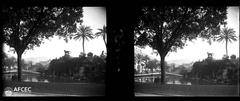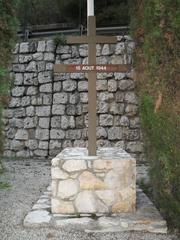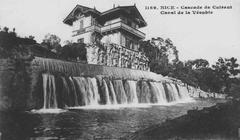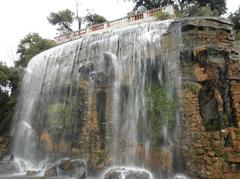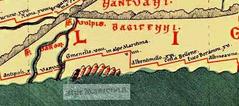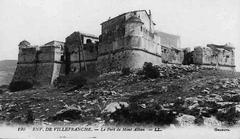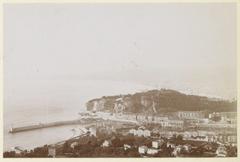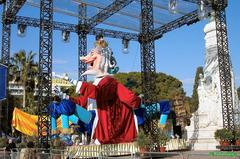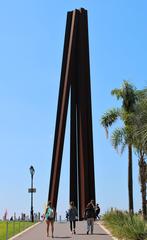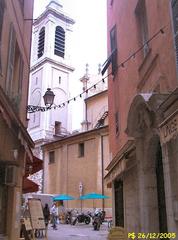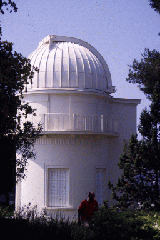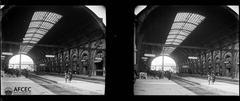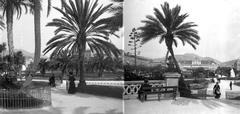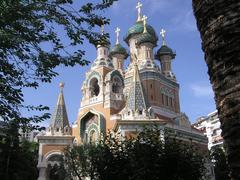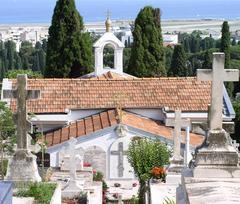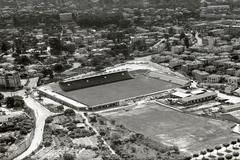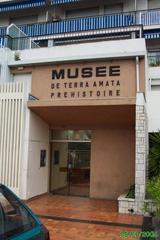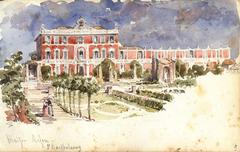Musée Matisse in Nice: Visiting Hours, Tickets, and More
Date: 18/07/2024
Introduction to Musée Matisse
Nestled in the picturesque city of Nice, France, the Musée Matisse stands as a beacon for art enthusiasts and tourists alike, offering an intimate glimpse into the life and works of Henri Matisse, one of the most influential artists of the 20th century. The museum is housed in the majestic Villa des Arènes, a 17th-century Genoese villa that Matisse himself once called home. This location is not just a repository of art but a living testament to Matisse’s profound connection with Nice, a city that inspired much of his most celebrated work.
The Musée Matisse provides visitors with a comprehensive journey through Matisse’s artistic evolution, from his early Fauvist experiments to his iconic cut-outs, encompassing a wide array of mediums including paintings, drawings, sculptures, and prints. With its rich history and carefully curated collection, the museum offers a unique and immersive experience that goes beyond mere observation, allowing visitors to engage deeply with the artist’s creative process and personal inspirations. Whether you’re an art aficionado or a casual visitor, the Musée Matisse promises an enriching and memorable experience. (source)
Contents Overview
- Introduction
- History and Significance of Musée Matisse
- Matisse’s Love Affair with Nice
- The Genesis of Musée Matisse
- The Musée Matisse Finds its Home - Villa des Arènes
- Exploring Matisse’s Artistic Journey
- Iconic Works and Hidden Gems
- Paintings - A Journey Through Color and Form
- Sculptures - Exploring Three Dimensions
- Drawings and Prints - Intimate Glimpses into the Creative Process
- Cut-Outs - A Late-Career Revelation
- Beyond the Canvas - Personal Objects and Inspiration
- Visitor Information
- Opening Hours
- Tickets
- Travel Tips
- Nearby Attractions
- Accessibility
- Special Events and Guided Tours
- Special Events
- Guided Tours
- Photographic Spots
- Conclusion
- FAQ
- What are the Musée Matisse visiting hours?
- How much are tickets to the Musée Matisse?
- Are there guided tours available?
- Is the Musée Matisse accessible?
- What other attractions are near the Musée Matisse?
History and Significance of Musée Matisse
The Musée Matisse is not just a repository of art; it’s a testament to the profound relationship between Henri Matisse and the city of Nice. This connection, woven into the museum’s very fabric, elevates it beyond a typical art institution, offering visitors a uniquely intimate glimpse into the artist’s life and creative evolution.
Matisse’s Love Affair with Nice
Henri Matisse, a leading figure in 20th-century art, first arrived in Nice in 1917, seeking respite from the dreary Parisian winter. He was immediately captivated by the French Riviera’s luminous light and vibrant colors, a stark contrast to the muted tones of his previous Parisian life. This transformative encounter with Nice’s radiant atmosphere profoundly impacted Matisse’s artistic style, pushing him towards the bold, expressive use of color that defines his later works.
Nice became Matisse’s muse and sanctuary. He spent a significant portion of his life in this coastal haven, drawing inspiration from its landscapes, people, and the very essence of Mediterranean life. From 1917 until his death in 1954, Nice was more than just a residence for Matisse; it was his artistic crucible, shaping his vision and nurturing his creativity.
The Genesis of Musée Matisse
The museum’s origins are intertwined with Matisse’s deep connection to Nice. The artist’s desire to give back to the city that had so profoundly influenced him led to the initial donation of a selection of his works to the Musée des Beaux-Arts in 1952. This act of generosity laid the foundation for what would eventually become the Musée Matisse.
Following Matisse’s death in 1954, his heirs continued his legacy, enriching the museum’s collection with further donations. This ongoing contribution ensured that the Musée Matisse would house a comprehensive representation of the artist’s oeuvre, spanning his entire career and encompassing various mediums.
The Musée Matisse Finds its Home - Villa des Arènes
The museum found its permanent home in 1963 within the walls of the magnificent Villa des Arènes, a 17th-century Genoese villa nestled in the heart of Nice. This architectural gem, with its ochre facade and verdant gardens, provides a stunning backdrop for Matisse’s vibrant masterpieces.
The choice of Villa des Arènes was no accident. Matisse himself resided in this very villa from 1938 to 1954, during which he produced some of his most celebrated works. Choosing this location imbued the museum with a unique sense of place, transforming it into a tangible link to the artist’s life and creative process.
Exploring Matisse’s Artistic Journey
The Musée Matisse houses an extensive collection of the artist’s work, offering a comprehensive overview of his artistic journey. Visitors can trace the evolution of Matisse’s style, from his early experiments with Fauvism, characterized by bold, non-naturalistic colors, to his later, more simplified yet equally powerful cut-out works.
The museum’s collection is not limited to paintings. It encompasses a diverse range of mediums, including sculptures, drawings, prints, and even illustrated books. This multifaceted approach provides a holistic understanding of Matisse’s creative genius, showcasing his mastery across various artistic disciplines.
Iconic Works and Hidden Gems
The Musée Matisse boasts an impressive collection of iconic works that draw art enthusiasts from around the globe. Among these treasures are:
- “Blue Nude” (1952) - This iconic cut-out exemplifies Matisse’s late-career mastery of form and color, using simple shapes to evoke a sense of movement and sensuality.
- “The Dance” (1909-1910) - A preliminary study for Matisse’s monumental masterpiece, this work captures the raw energy and primal rhythm of dance through its dynamic composition and vibrant palette.
- “Flowers and Ceramic Plate” (1913) - This still life demonstrates Matisse’s ability to infuse everyday objects with a sense of quiet beauty and contemplative stillness.
Beyond these renowned pieces, the museum also houses a wealth of lesser-known works that offer fascinating insights into Matisse’s artistic process and personal reflections. Sketches, preliminary studies, and personal objects provide a glimpse into the artist’s mind, revealing the inspiration and meticulous work behind his iconic creations.
Paintings - A Journey Through Color and Form
Matisse’s mastery of color and form is evident throughout his paintings, which form a significant part of the museum’s collection.
- Early Works - The collection features early paintings like “Nature Morte avec des Livres” (Still Life with Books) from 1890, showcasing Matisse’s academic training and his initial forays into Impressionism.
- Fauvist Period - The museum holds a remarkable collection from Matisse’s Fauvist period, a movement characterized by bold, unrealistic colors and expressive brushwork. Key works include “La Japonaise au Peignoir” (The Japanese Woman) and “Le Luxe I” (Luxury I), both painted in 1907. These paintings demonstrate Matisse’s revolutionary use of color to convey emotion and energy.
- Nice Period - Matisse’s move to Nice in 1917 marked a shift towards more serene and decorative compositions. The museum houses an impressive collection from this period, including “Le Chant” (The Song) and “La Danse” (The Dance), two monumental decorative panels originally commissioned by Sergei Shchukin. These works exemplify Matisse’s exploration of rhythm, movement, and the human form.
Sculptures - Exploring Three Dimensions
While Matisse is primarily known for his paintings, sculpture played a crucial role in his artistic development. The Musée Matisse holds a significant collection of his sculptures, offering insights into his exploration of form and volume.
- Early Sculptures - The collection includes early sculptures like “Jaguar Devouring a Hare” (1898), reflecting Matisse’s academic training and his interest in depicting movement and tension.
- Developing Style - As Matisse’s style evolved, his sculptures became more simplified and expressive. Works like “Nu Debout, Bras Gauche sur la Tête” (Standing Nude with Left Arm Raised) (1906) demonstrate his growing interest in capturing the essence of the human form through simplified lines and volumes.
- Recurring Themes - The museum’s collection highlights recurring themes in Matisse’s sculptures, such as the female nude, dance, and the exploration of space and volume.
Drawings and Prints - Intimate Glimpses into the Creative Process
The Musée Matisse houses a rich collection of Matisse’s drawings and prints, offering intimate glimpses into his creative process and his mastery of line and form.
- Line as Expression - Matisse viewed drawing as the foundation of his art. The collection showcases his exceptional draftsmanship and his ability to convey emotion and movement through line alone.
- Preparatory Studies - Many drawings in the collection are preparatory studies for Matisse’s paintings and sculptures, providing valuable insights into his artistic process and the evolution of his ideas.
- Printmaking Techniques - The museum also holds a variety of Matisse’s prints, including lithographs, etchings, and linocuts. These works demonstrate his experimentation with different printmaking techniques and his ability to translate his artistic vision across various mediums.
Cut-Outs - A Late-Career Revelation
Towards the end of his career, Matisse developed a groundbreaking technique using cut-outs from brightly colored paper. The Musée Matisse holds a significant collection of these works, showcasing the vibrancy and innovation of his late period.
- Origin and Development - The cut-out technique allowed Matisse to create art despite his declining health. He would cut shapes directly from painted paper and arrange them into compositions, exploring color, form, and space in a new and liberating way.
- Key Works - The collection features iconic cut-out works like “La Tristesse du Roi” (The Sorrow of the King) (1952) and “L’Escargot” (The Snail) (1953). These pieces demonstrate Matisse’s mastery of color and composition, even within the constraints of his chosen medium.
- Legacy of Innovation - Matisse’s cut-outs were revolutionary for their time and continue to inspire artists today. The Musée Matisse’s collection offers a unique opportunity to experience the vibrancy and ingenuity of these late masterpieces.
Beyond the Canvas - Personal Objects and Inspiration
The Musée Matisse goes beyond showcasing finished artworks, offering a glimpse into the artist’s life and inspirations through a collection of personal objects and archival materials.
- Artist’s Studio - The museum recreates the ambiance of Matisse’s studio, displaying his furniture, painting tools, and personal belongings. This immersive experience provides a deeper understanding of his creative environment and daily life.
- Photographs and Documents - The collection includes photographs of Matisse throughout his life, personal letters, and exhibition catalogs. These archival materials offer valuable insights into his personality, relationships, and artistic journey.
- Objects of Inspiration - The museum also displays objects that inspired Matisse, such as textiles, ceramics, and sculptures from different cultures. These objects highlight the diverse influences that shaped his artistic vision.
Visitor Information
Opening Hours
The Musée Matisse is open daily from 10:00 AM to 6:00 PM, except on Tuesdays and certain holidays. Be sure to check the official website for any changes to these hours.
Tickets
Ticket prices are as follows:
- Adults - €10
- Reduced rate - €5 (students, seniors, etc.)
- Free entry - Children under 18, residents of Nice, and the first Sunday of each month
Tickets can be purchased online or at the museum’s entrance.
Travel Tips
The museum is easily accessible via public transportation. Take bus lines 15 or 17 and get off at the ‘Les Arènes / Musée Matisse’ stop. Alternatively, you can enjoy a scenic walk through the city to reach the museum.
Nearby Attractions
While visiting the Musée Matisse, consider exploring other nearby attractions such as the Cimiez Monastery, the Archaeological Museum of Nice, and the beautiful Cimiez Gardens.
Accessibility
The museum is wheelchair accessible, with elevators and ramps available for easy navigation.
Special Events and Guided Tours
Special Events
The Musée Matisse frequently hosts temporary exhibitions, workshops, and cultural events that delve deeper into Matisse’s work and its impact on contemporary art. Check the museum’s calendar for upcoming events during your visit.
Guided Tours
Guided tours are available for those who wish to gain a deeper understanding of Matisse’s works and the museum’s collection. Tours can be booked in advance through the museum’s official website.
Photographic Spots
Don’t miss the chance to capture the beauty of the Villa des Arènes and its gardens. Some of the best photographic spots include the villa’s facade, the lush gardens, and the views of Nice from the museum.
Conclusion
The Musée Matisse is more than just a museum; it’s a living testament to the enduring legacy of Henri Matisse. It stands as a tribute to his artistic genius, his deep connection to Nice, and the transformative power of art. The museum continues to evolve, hosting temporary exhibitions that explore different facets of Matisse’s work and its influence on contemporary art. These exhibitions, often featuring works by other renowned artists, provide fresh perspectives on Matisse’s legacy, ensuring its continued relevance and appeal to a global audience.
FAQ
What are the Musée Matisse visiting hours?
The museum is open daily from 10:00 AM to 6:00 PM, except on Tuesdays and certain holidays.
How much are tickets to the Musée Matisse?
Tickets are €10 for adults, €5 for reduced rates, and free for children under 18, residents of Nice, and on the first Sunday of each month.
Are there guided tours available?
Yes, guided tours can be booked in advance through the museum’s official website.
Is the Musée Matisse accessible?
Yes, the museum is wheelchair accessible with elevators and ramps.
What other attractions are near the Musée Matisse?
The museum is located in the Cimiez district, close to the Roman ruins and the Monastery of Cimiez. The surrounding gardens also offer a beautiful setting for a stroll.
Visit and Stay Up to Date
For more information and updates on the Musée Matisse, visit the official Musée Matisse website and follow them on social media. Don’t forget to download the mobile app Audiala for an enhanced experience during your visit.
Summary and Final Thoughts
In conclusion, the Musée Matisse in Nice offers more than just an exhibition of artworks; it provides a profound journey into the life and creative genius of Henri Matisse. The museum’s extensive collection, housed in the historically significant Villa des Arènes, serves as both a tribute to Matisse’s artistic legacy and a testament to his enduring connection with the city of Nice. Visitors can explore a diverse array of Matisse’s works, from his early Fauvist paintings to his innovative cut-outs, and gain insights into his artistic process through personal objects and archival materials. The museum’s accessibility, well-organized visitor information, and engaging special events ensure a fulfilling experience for all guests. As you wander through the museum’s halls, you’ll not only witness Matisse’s mastery of color and form but also feel the emotional resonance of his art, making your visit truly unforgettable. Don’t miss the opportunity to immerse yourself in the world of Henri Matisse at this iconic museum, and be sure to explore the surrounding attractions in Nice to complete your cultural journey. (source)
